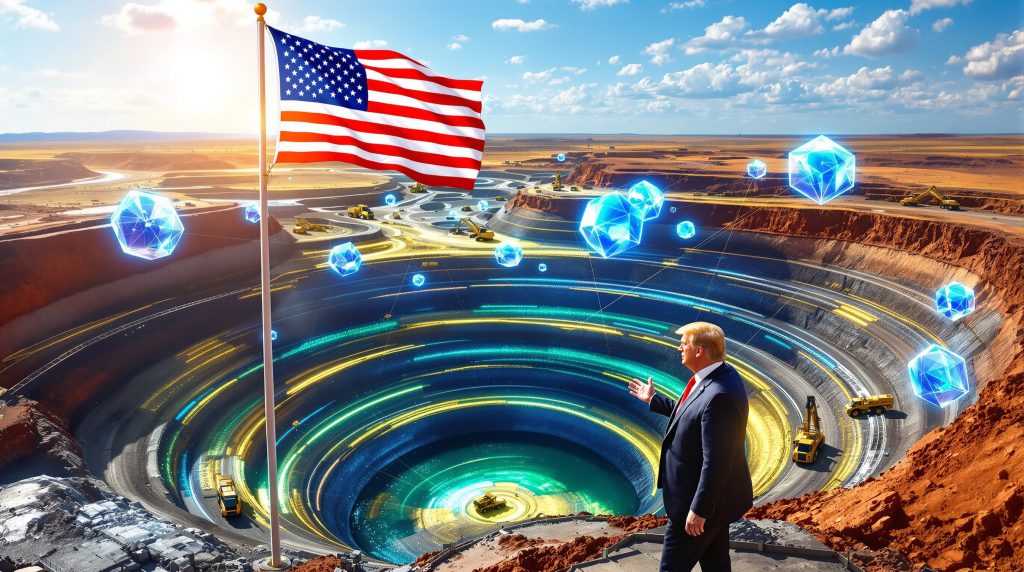A Strategic Partnership Reshaping Global Supply Chains
The minerals landscape experienced a seismic shift on October 20, 2025, when President Donald Trump and Australian Prime Minister Anthony Albanese formalized an $8.5 billion critical minerals agreement at the White House. This historic accord represents far more than a bilateral trade deal; it signals a fundamental restructuring of global supply chains that have been dominated by Chinese production for decades.
The timing proves particularly significant given China's recent implementation of unprecedented export restrictions on rare earth elements, creating supply disruptions that have sent shockwaves through technology, defense, and renewable energy sectors worldwide. This Trump agreement on critical minerals with Australia establishes a framework for reducing Western dependence on Chinese-controlled resources while positioning Australia as the cornerstone of an alternative supply network.
Furthermore, the Trump critical minerals order demonstrates the administration's commitment to securing strategic mineral supplies through coordinated policy initiatives.
Core Elements of the $8.5 Billion Investment Framework
The partnership encompasses a comprehensive investment pipeline valued at $8.5 billion, representing projects ready for immediate deployment following four to five months of intensive negotiations. The agreement structure emphasizes equity-style investments rather than traditional trade arrangements, with the United States seeking ownership stakes in Australian mining operations to ensure long-term supply security.
Key Agreement Components:
• Investment Value: $8.5 billion in ready-to-implement mining projects
• Negotiation Timeline: 4-5 months of bilateral discussions preceding the formal signing
• Implementation Projection: Expected operational capacity within 12 months
• Equity Structure: US government pursuing ownership stakes in Australian mining companies
• Agency Coordination: Multi-department US government involvement with over a dozen Australian mining firms
The partnership extends beyond traditional resource extraction to encompass downstream processing capabilities, technology transfer initiatives, and integrated supply chain development. This holistic approach addresses vulnerabilities exposed by recent supply chain disruptions while creating redundancies that enhance global economic resilience.
Strategic mineral categories covered under the agreement include rare earth elements essential for advanced electronics, critical battery minerals supporting the energy transition, defense-grade materials for military applications, and specialized elements required for semiconductor manufacturing. The comprehensive scope reflects the interconnected nature of modern industrial supply chains and the strategic importance of securing reliable access to these foundational materials.
In addition, the Australia critical minerals reserve initiative complements this partnership by providing strategic stockpiling capabilities.
Breaking China's Resource Dominance Through Australian Partnerships
Australia's geological endowment positions the nation as a viable alternative to Chinese supply chains, holding the world's fourth-largest rare earth deposits alongside substantial reserves of lithium, cobalt, and other critical minerals. The country's unique advantage lies not only in resource abundance but in its established mining infrastructure, regulatory framework, and political stability that attracts international investment capital.
Australia's Strategic Advantages:
• Rare Earth Deposits: Fourth-largest global reserves providing supply diversity
• Heavy Rare Earths: Lynas Rare Earths operates the only heavy rare earth production facility outside China
• Mining Expertise: Decades of operational experience in large-scale resource extraction
• Political Stability: Democratic governance providing investment security for long-term projects
• Infrastructure: Established transportation and processing networks supporting immediate expansion
Lynas Rare Earths Ltd. represents the cornerstone of non-Chinese heavy rare earth production, processing materials essential for permanent magnets used in wind turbines, electric vehicles, and advanced military systems. Heavy rare earths, including dysprosium and terbium, exhibit properties that make them irreplaceable in high-performance applications, distinguishing them from more abundant light rare earth elements.
"The agreement positions Australia as a viable alternative supplier for industries spanning semiconductors, defense technology, renewable energy, and advanced manufacturing sectors previously dependent on Chinese sources."
Recent Chinese export restrictions have created supply uncertainties that underscore the vulnerability of single-source dependencies. Furthermore, according to Mining.com, US Treasury Secretary Scott Bessent's confirmation that allied nations are coordinating responses to these restrictions demonstrates the broader strategic implications extending well beyond bilateral US-Australia relations.
Economic Transformation and Investment Opportunities for Australia
The Trump agreement on critical minerals with Australia creates unprecedented opportunities for Australian mining companies while attracting significant international capital investment. The partnership structure enables Australian firms to access US government backing while maintaining operational control over their domestic resources.
Projected Economic Benefits:
| Economic Impact Category | Estimated Value | Timeline |
|---|---|---|
| Direct Investment Pipeline | $8.5 billion | 2025-2030 |
| Job Creation (Direct) | 15,000-25,000 positions | 2025-2027 |
| Export Revenue Increase | $3-5 billion annually | 2027-2030 |
| Infrastructure Investment | $2-3 billion | 2025-2028 |
Australian Treasurer Jim Chalmers' engagement with major US investment firms, including Blackstone Inc. and Blue Owl Capital, demonstrates the partnership's appeal to private equity markets seeking exposure to critical mineral assets. These discussions occurred during the week of October 13, 2025, positioning Australia as a stable, resource-rich destination for global capital deployment.
The agreement enables Australia to leverage its mining sector expertise while developing downstream processing capabilities that add value beyond raw material extraction. This vertical integration approach creates higher-skilled employment opportunities while capturing greater margins from the global supply chain.
Regional development benefits extend beyond major mining centers, with supporting infrastructure projects creating economic opportunities in transportation, logistics, and manufacturing sectors. The multiplier effects of large-scale mining investments typically generate 2-3 indirect jobs for every direct mining position, amplifying the economic impact across local communities.
Similarly, India's lithium supply strategy demonstrates how other nations are actively seeking partnerships with Australia to secure critical mineral supplies.
Geopolitical Realignment and Allied Coordination Strategies
The partnership represents a strategic response to China's weaponization of critical mineral exports, demonstrating how resource-rich allied nations can coordinate to maintain supply chain security. China's recent export restrictions created immediate concerns across defense contractors, technology manufacturers, and renewable energy developers who rely on consistent material flows.
Strategic Implications:
• Alliance Strengthening: Integration with existing AUKUS defense partnership framework
• Supply Chain Resilience: Development of alternative sourcing networks reducing single-point failures
• Technology Security: Protection of advanced manufacturing capabilities dependent on critical materials
• Economic Leverage: Coordination among allies to counter economic coercion tactics
The agreement occurs within the broader context of intensifying great power competition, where control over critical resources increasingly determines technological and military capabilities. Prime Minister Albanese's first White House visit since Trump's return to office underscores the strategic priority both nations place on resource security cooperation.
US government coordination involves multiple agencies working with over a dozen Australian mining firms, indicating the comprehensive nature of the partnership extending beyond simple trade relationships. This multi-agency approach enables coordinated responses to supply disruptions while ensuring strategic mineral access aligns with broader national security objectives.
Moreover, the US-China trade war impact continues to influence global supply chain decisions and strategic partnerships between allied nations.
Mining Companies Positioned for Strategic Growth
Australian mining companies stand to benefit significantly from the partnership, with Lynas Rare Earths Ltd. occupying a particularly advantageous position as the sole heavy rare earth producer outside Chinese control. The company's Malaysian processing facility and Australian mining operations provide a complete supply chain alternative for critical defense and technology applications.
Key Australian Critical Mineral Producers:
| Company | Primary Commodities | Current Status | Strategic Advantage |
|---|---|---|---|
| Lynas Rare Earths | Heavy rare earths | Operating production | Only non-Chinese heavy RE producer |
| Pilbara Minerals | Lithium (spodumene) | Major producer | Battery mineral focus |
| Iluka Resources | Mineral sands, rare earths | Development stage | Integrated processing capabilities |
| Northern Minerals | Heavy rare earths | Development | Dysprosium-rich deposits |
The equity investment structure creates opportunities for US capital to support Australian mining expansion while maintaining Australian operational control. This model addresses US supply security concerns while respecting Australian sovereignty over domestic resources, creating a framework potentially applicable to other allied partnerships.
Private equity involvement from firms like Blackstone and Blue Owl Capital indicates institutional investor confidence in critical mineral markets. These firms typically seek assets with long-term contracted cash flows and inflation-protected pricing mechanisms, characteristics that align well with strategic mineral supply agreements.
More than a dozen Australian mining firms participated in Washington meetings during September 2025, indicating broad industry engagement beyond the largest established producers. This participation suggests opportunities for mid-tier and development-stage companies to access US capital markets and government support programs.
The battery metals investment landscape continues to evolve as strategic partnerships reshape funding opportunities for Australian producers.
International Mining Partnership Benchmarking
The Australia-US critical minerals agreement establishes new standards for resource security partnerships among allied nations. Compared to traditional trade agreements focused on tariff reduction, this framework emphasizes investment integration and supply chain resilience through equity participation and technology sharing.
Comparative Partnership Analysis:
| Partnership | Investment Value | Timeline | Key Focus Areas |
|---|---|---|---|
| US-Australia | $8.5 billion | 2025-2030 | Rare earths, critical minerals |
| US-Canada | $3.2 billion | 2022-2027 | Battery minerals, rare earths |
| Japan-Australia | $2.1 billion | 2021-2026 | Energy transition metals |
| EU-Australia | $1.8 billion | 2023-2028 | Green technology materials |
The Trump agreement on critical minerals with Australia exceeds comparable international partnerships in both scale and strategic scope. The equity investment structure differentiates this agreement from traditional trade relationships, creating deeper integration between US and Australian resource sectors.
Canada-US cooperation focuses primarily on battery mineral supply chains supporting North American automotive manufacturing, while the Australia partnership encompasses broader defense and technology applications. The geographic diversification reduces supply chain vulnerabilities while creating competitive alternatives to Chinese-dominated markets.
European Union partnerships typically emphasize environmental standards and sustainable mining practices, reflecting different regulatory priorities compared to the US focus on supply security and defense applications. These varying approaches create opportunities for Australian producers to serve multiple markets with differentiated value propositions.
Implementation Challenges and Risk Mitigation Strategies
Despite the partnership's strategic advantages, significant challenges could impact successful implementation. Infrastructure development requirements, environmental compliance obligations, and market volatility risks require careful management to achieve projected outcomes.
Primary Implementation Risks:
• Infrastructure Capacity: Processing facilities and transportation networks require substantial capital investment
• Regulatory Coordination: Environmental approvals and permitting across multiple jurisdictions
• Market Volatility: Commodity price fluctuations affecting project economics
• Technical Complexity: Heavy rare earth processing requires specialized expertise and technology
• Capital Requirements: $8.5 billion investment demands sustained financial commitment over multiple years
"Commodity price volatility represents a significant risk factor, with rare earth prices experiencing 40-60% annual fluctuations based on supply disruptions and demand cycles."
Environmental compliance presents particular challenges for rare earth processing, which generates radioactive waste requiring specialized handling and disposal. Australian regulatory frameworks provide established procedures, but scaling production may require additional environmental impact assessments and community engagement processes.
Technical expertise requirements for heavy rare earth processing create potential bottlenecks, as specialized knowledge remains concentrated among relatively few global practitioners. Technology transfer provisions within the partnership could address these constraints while building Australian processing capabilities.
Transportation infrastructure connecting remote mining locations to processing facilities and export terminals requires coordination between government and private sector investment. The partnership's equity structure enables shared responsibility for infrastructure development while ensuring strategic access to essential facilities.
Market Transformation and Supply Chain Diversification
The partnership's implementation will fundamentally alter global critical mineral markets by introducing substantial supply capacity outside Chinese control. This diversification reduces market concentration while creating competitive pricing dynamics that benefit end-users across multiple industries.
Projected Market Share Evolution:
| Mineral Category | Current Chinese Share | Projected Post-2030 | Australian Contribution |
|---|---|---|---|
| Heavy Rare Earths | 95% | 70-75% | 20-25% |
| Light Rare Earths | 85% | 65-70% | 15-20% |
| Lithium Processing | 60% | 45-50% | 25-30% |
| Critical Minerals Overall | 70% | 55-60% | 20-25% |
Supply chain diversification benefits extend beyond price considerations to encompass reliability, quality consistency, and strategic security. Australian producers operate under transparent regulatory frameworks that provide greater visibility into production capacity and delivery timelines compared to state-controlled alternatives.
Technology sector supply chains will experience the most significant benefits from diversification, as consistent material flows enable long-term production planning and capacity expansion. Defense contractors particularly value supply sources aligned with national security objectives and subject to allied government oversight.
The partnership creates opportunities for price discovery mechanisms that reflect true market dynamics rather than strategic manipulation. Increased competition typically leads to more efficient resource allocation and innovation in processing technologies that benefit the entire industry.
Future Expansion and Strategic Development Pathways
The current agreement establishes a foundation for expanded cooperation across additional mineral categories and technological applications. President Trump's projection of substantial supply increases within 12 months suggests aggressive implementation timelines that could accelerate market transformation.
Development Timeline and Milestones:
Short-term Objectives (2025-2027):
• Project financing completion for initial $3 billion investment phase
• Environmental approvals and permitting for major expansion projects
• Infrastructure development connecting mining operations to processing facilities
• Workforce training programs for specialized processing operations
Medium-term Targets (2027-2030):
• Production capacity increases of 200-300% for heavy rare earths
• Downstream processing facility construction and commissioning
• Technology transfer programs enhancing Australian capabilities
• Market share gains across multiple critical mineral categories
Long-term Strategic Vision (2030+):
• Comprehensive alternative supply network reducing Chinese dependencies
• Advanced materials research and development collaboration
• Next-generation mining and processing technology deployment
• Integration with broader allied supply chain security initiatives
Future expansion opportunities include additional mineral categories such as antimony, tungsten, and specialized alloys used in aerospace applications. The partnership framework provides a template for incorporating these materials as strategic priorities evolve and new technology requirements emerge.
Technology transfer initiatives could accelerate Australian development of advanced processing capabilities while creating intellectual property shared between allied nations. This collaboration model enhances collective technological capabilities while maintaining competitive advantages over non-allied producers.
According to Reuters, the partnership discussions encompassed broader security arrangements and future expansion possibilities.
Transforming Global Resource Security Architecture
The Trump agreement on critical minerals with Australia represents more than a bilateral trade arrangement; it establishes a new paradigm for resource security cooperation among democratic allies. The partnership demonstrates how strategic coordination can effectively counter economic coercion while building resilient supply chains that support technological advancement and national security.
Australia's emergence as a critical minerals superpower, backed by US investment and strategic partnership, creates alternatives to Chinese-dominated supply chains that have constrained Western technological development. The $8.5 billion investment pipeline provides the foundation for sustained competition in global markets while ensuring allied nations maintain access to materials essential for defense, technology, and energy transition applications.
The agreement's equity investment structure creates deeper integration than traditional trade relationships, aligning long-term interests while respecting national sovereignty over domestic resources. This model offers a template for similar partnerships with other resource-rich allied nations, potentially creating a comprehensive network of alternative supply sources.
Success in implementing this partnership will determine whether democratic allies can effectively coordinate economic resources to maintain technological leadership and strategic independence. The stakes extend well beyond mineral markets to encompass the broader competition for technological supremacy and economic influence in the 21st century global economy.
Looking to Capitalise on Australia's Critical Minerals Boom?
Discovery Alert's proprietary Discovery IQ model delivers real-time notifications on significant ASX mineral discoveries, instantly empowering subscribers to identify actionable opportunities in Australia's rapidly expanding critical minerals sector. Understand why major mineral discoveries can lead to substantial market returns by exploring Discovery Alert's dedicated discoveries page, showcasing historic examples of exceptional outcomes, and begin your 30-day free trial today to position yourself ahead of the market.




